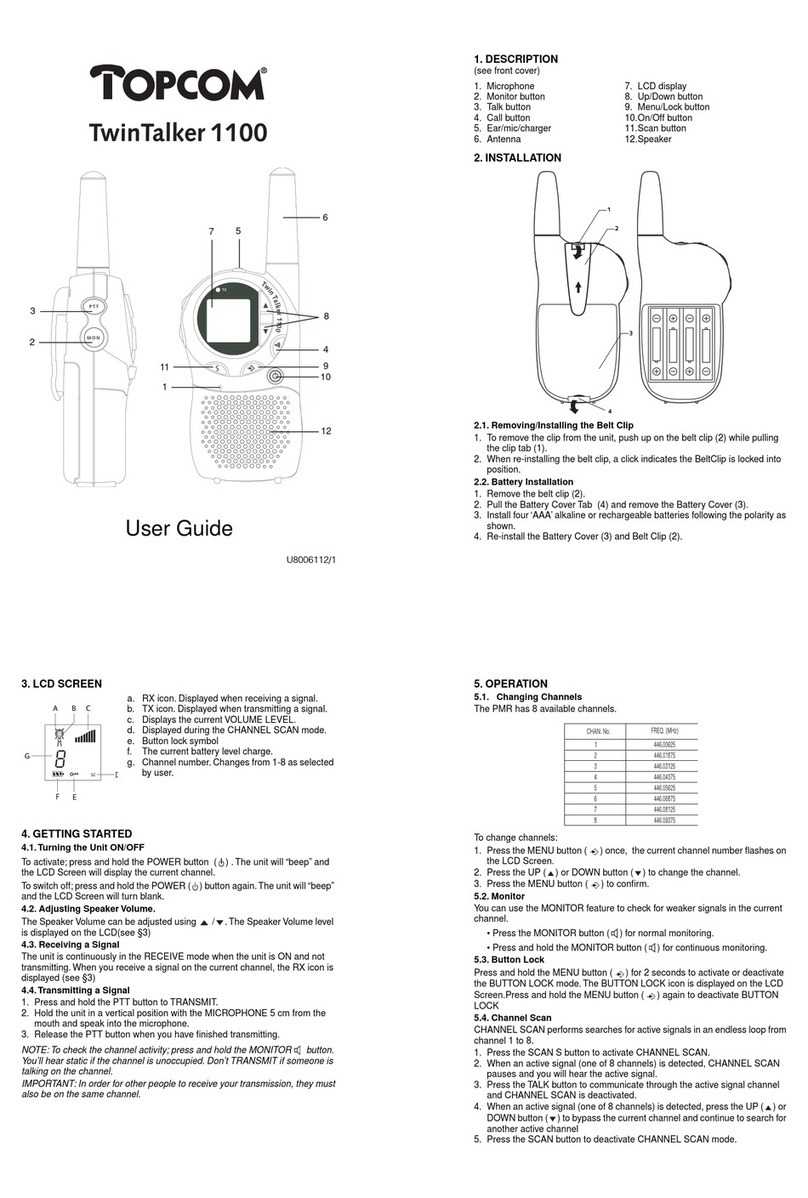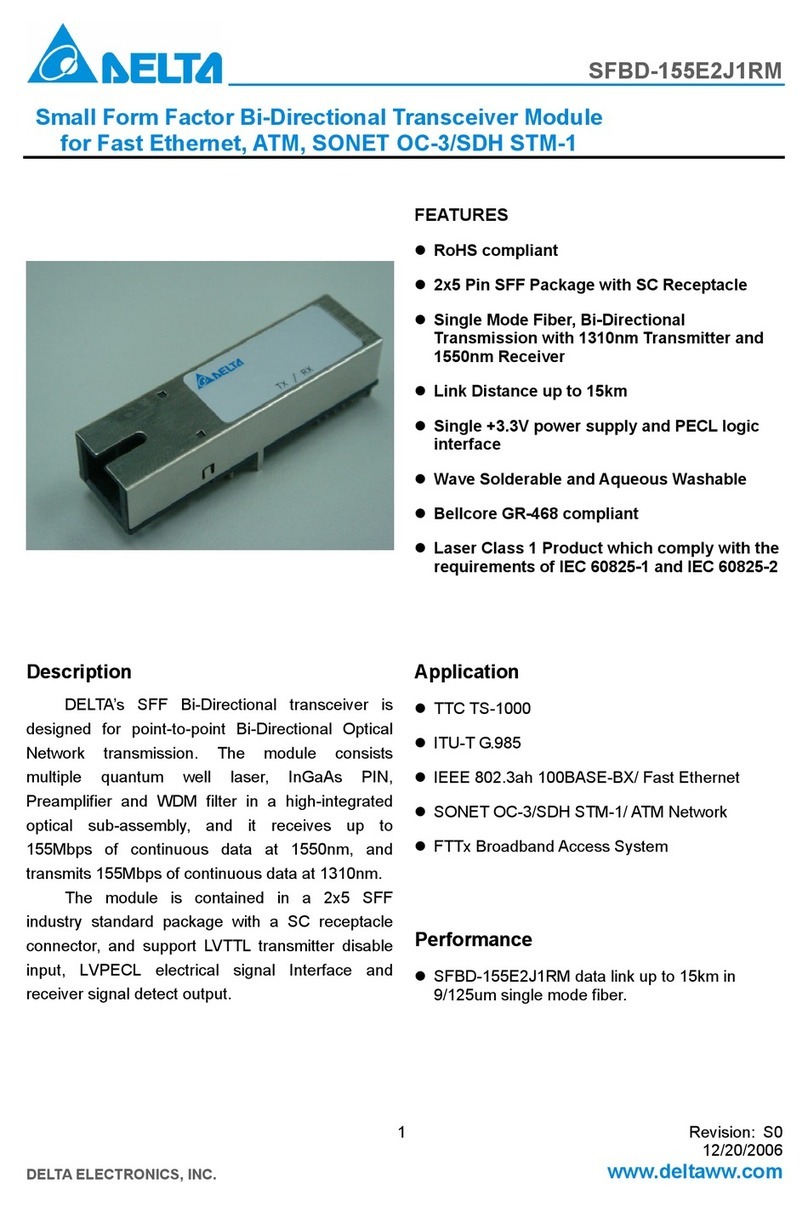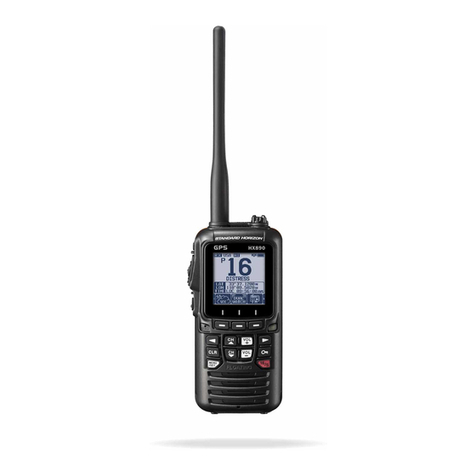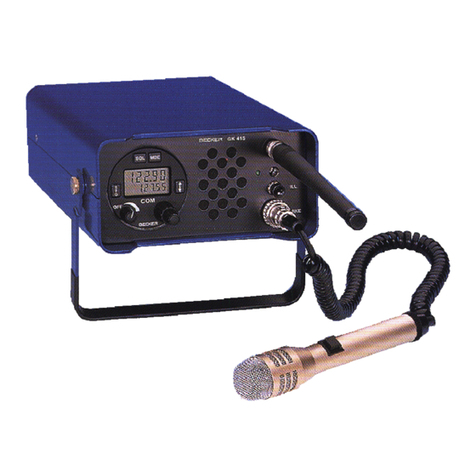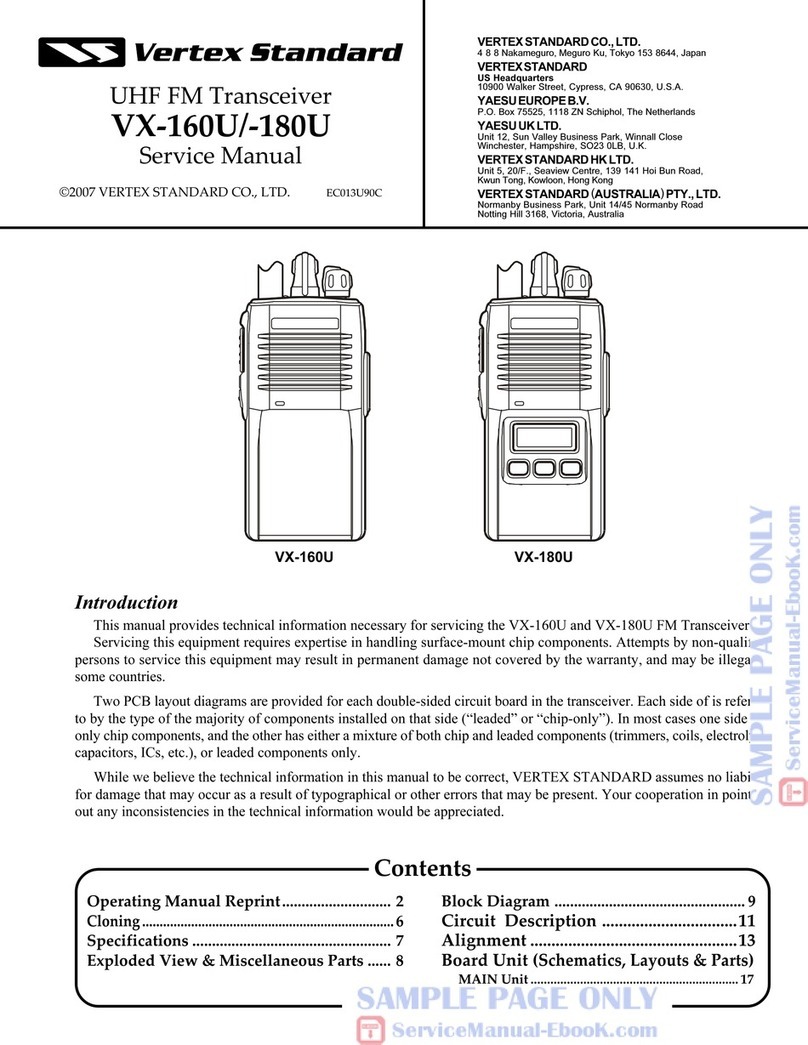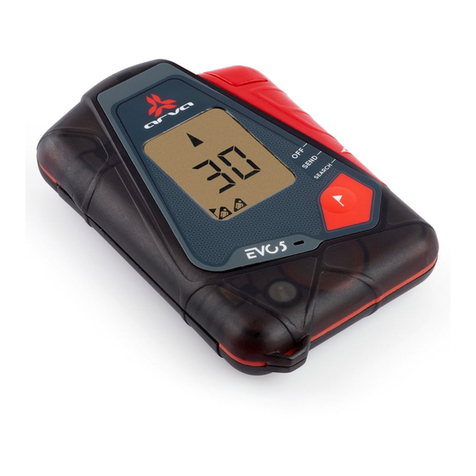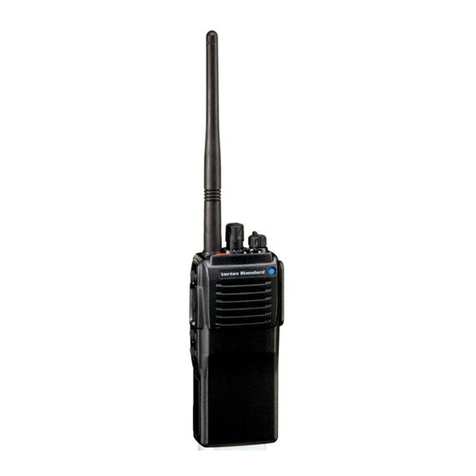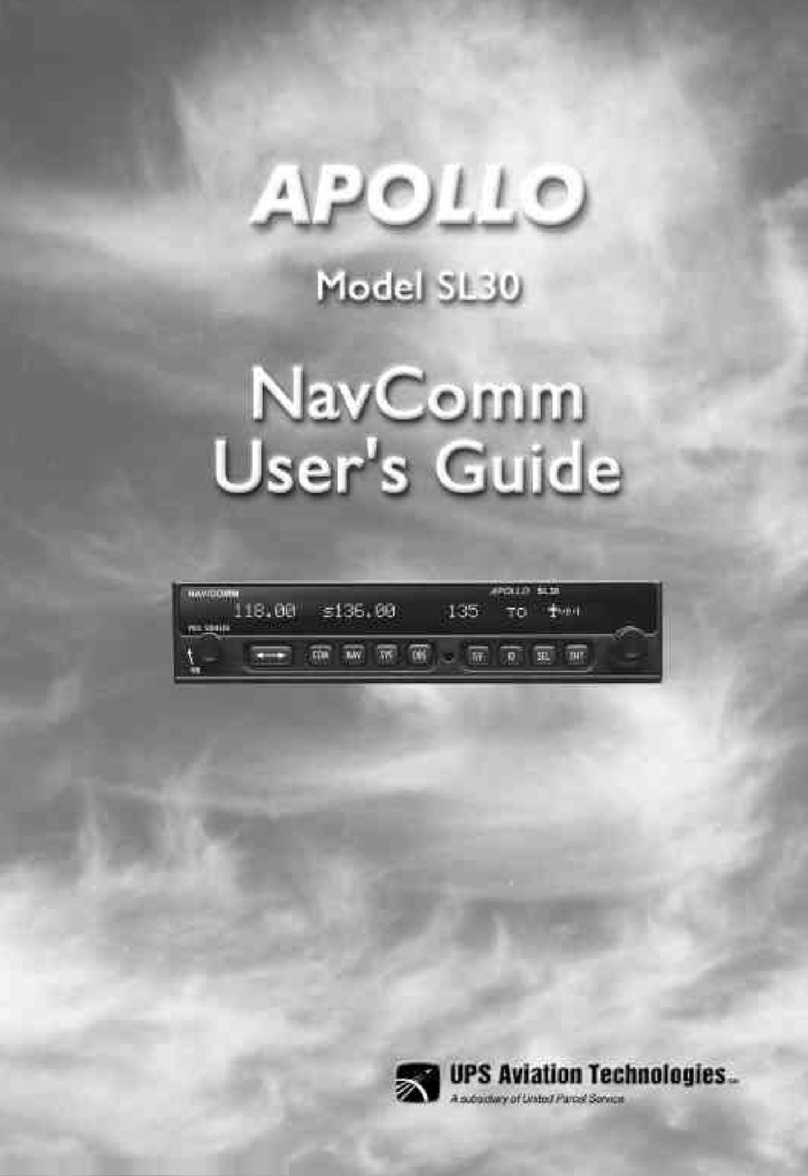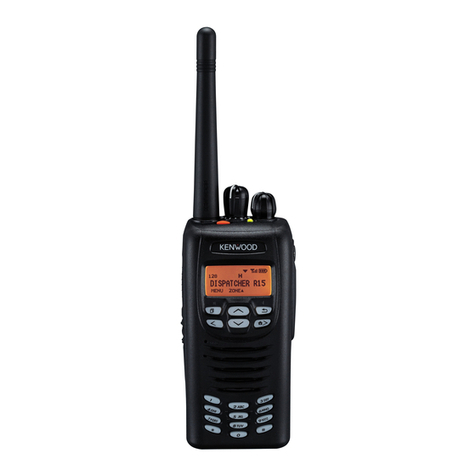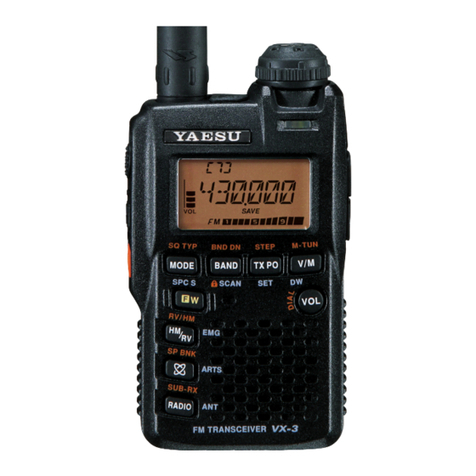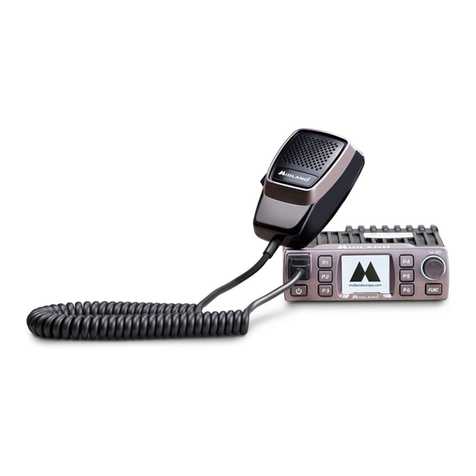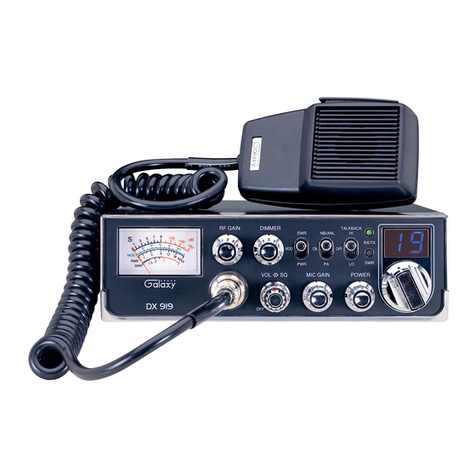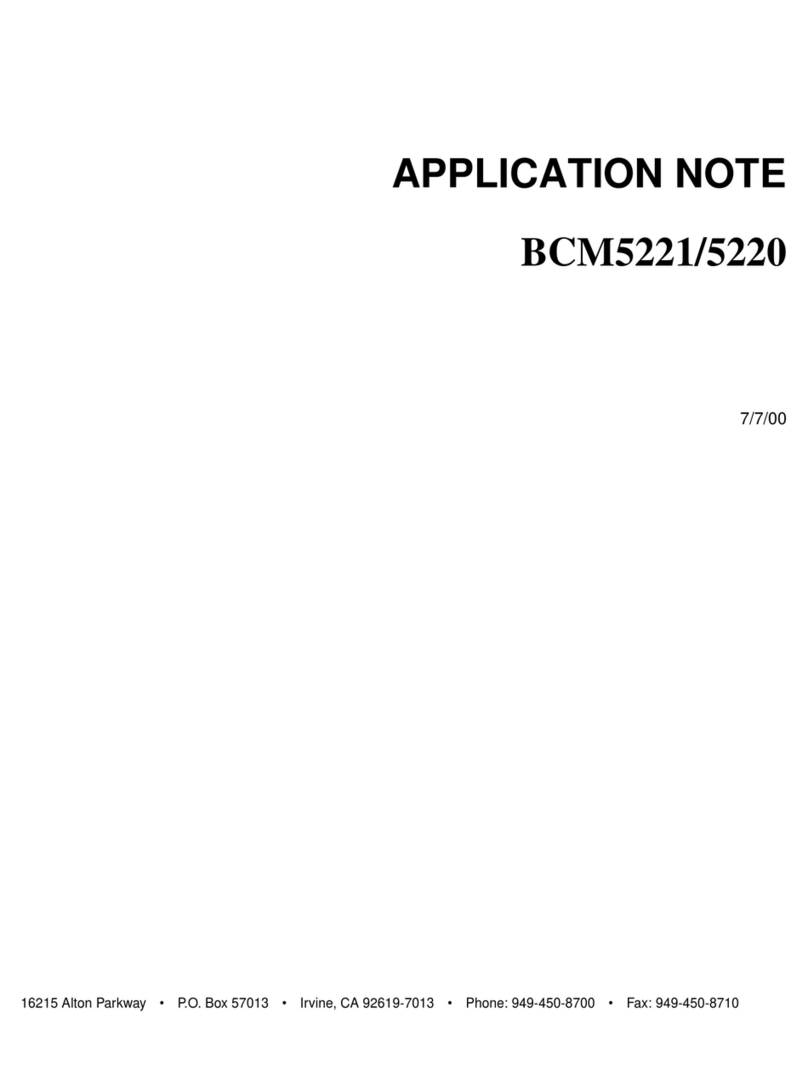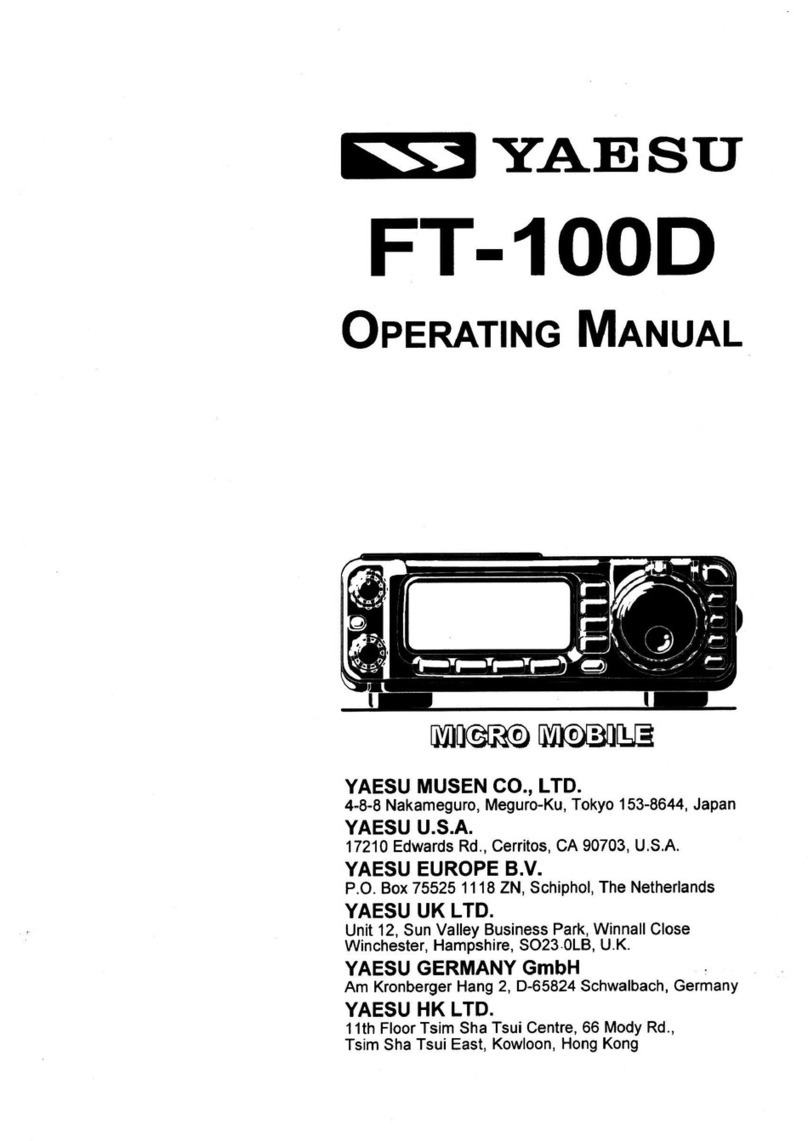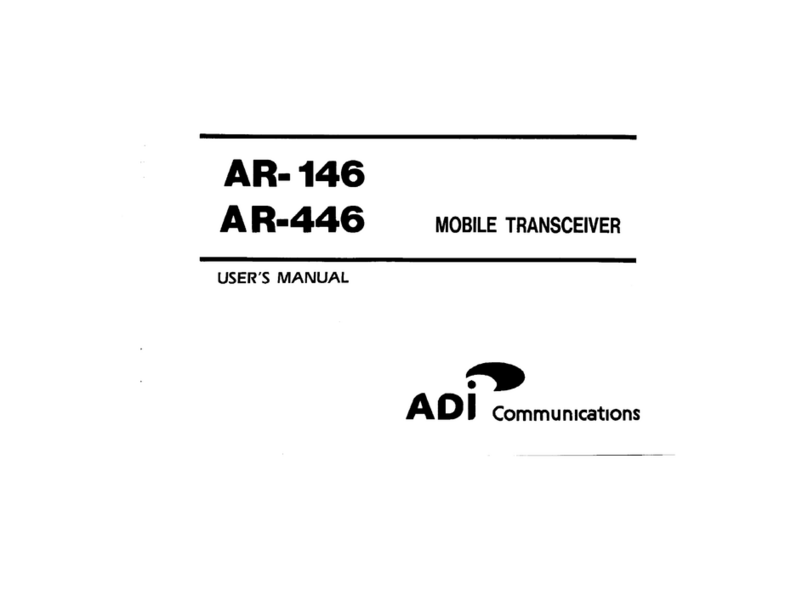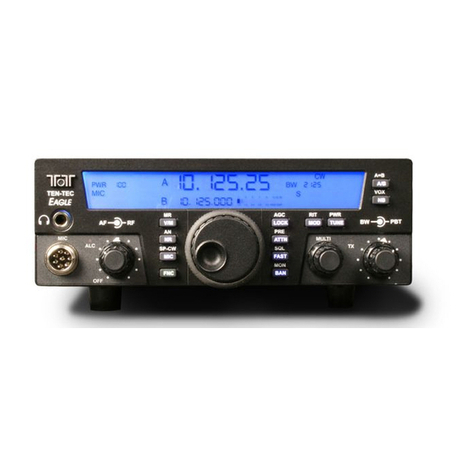Linx NT Series Instruction Manual

NT Series
Transceiver Module
Data Guide

Warning: Linx radio frequency ("RF") products may be
used to control machinery or devices remotely, including machinery
or devices that can cause death, bodily injuries, and/or property
damage if improperly or inadvertently triggered, particularly in industrial
settings or other applications implicating life-safety concerns. No Linx
Technologies product is intended for use in any application without
redundancies where the safety of life or property is at risk.
The customers and users of devices and machinery controlled with
RF products must understand and must use all appropriate safety
procedures in connection with the devices, including without limitation,
using appropriate safety procedures to prevent inadvertent triggering by
the user of the device and using appropriate security codes to prevent
triggering of the remote controlled machine or device by users of other
remote controllers.
Do not use this or any Linx product to trigger an action directly
from the data line or RSSI lines without a protocol or encoder/
decoder to validate the data. Without validation, any signal from
another unrelated transmitter in the environment received by the module
could inadvertently trigger the action. This module does not have data
validation built in.
All RF products are susceptible to RF interference that can prevent
communication. RF products without frequency agility or hopping
implemented are more subject to interference. This module does
not have frequency agility built in, but the developer can implement
frequency agility with a microcontroller and the example code in Linx
Reference Guide RG-00101.
Do not use any Linx product over the limits in this data guide.
Excessive voltage or extended operation at the maximum voltage could
cause product failure. Exceeding the reflow temperature profile could
cause product failure which is not immediately evident.
Do not make any physical or electrical modifications to any Linx
product. This will void the warranty and regulatory and UL certifications
and may cause product failure which is not immediately evident.
!Table Of Contents
1 Description
1 Features
2 Ordering Information
2 Absolute Maximum Ratings
3 Electrical Specications
6 Typical Performance Graphs
11 Module Description
11 Theory of Operation
12 Pin Assignments
12 Pin Descriptions
14 Sending Data
14 The Data Input
15 The Data Output
15 Using the RSSI Line
16 Using the T/R_SEL Input
16 Using the Low Power Features
17 Using the READY Output
17 Using the LVL_ADJ Line
18 Baud Band Selection
19 Channel Selection
20 European Transmission Rules
23 Typical Applications
24 Power Supply Requirements
24 Antenna Considerations
25 Protocol Guidelines
26 Interference Considerations
27 Pad Layout
27 Board Layout Guidelines
29 Microstrip Details

– –
1
Description
The NT Series transceiver module is designed
for bi-directional wireless data transfer. The
868MHz version is suitable for European
operation and the 900MHz version is suitable
for North and South America. The modules
have an outstanding range of up to 3,000 feet
(914 meters, line of sight). Low power states
optimize current consumption for battery-powered devices.
The modules have two interfaces for data transfer. The first uses a standard
Universal Asynchronous Receiver Transmitter (UART) with a simple built-in
protocol that supports data rates of 9.6kbps or 56kbps (see Reference
Guide 00102). The other option is a transparent interface that bypasses the
protocol engine and directly modulates the RF carrier. This supports data
rates of up to 300kbps.
The basic configuration settings are done in hardware through the logic
state of several pins on the module. Optionally the UART interface can be
used for software configuration, also giving access to additional features.
The modules are capable of generating +12.5dBm into 50-ohms and have
a typical sensitivity of −113dBm. Housed in a compact reflow-compatible
SMD package, the transceivers require no external RF components except
an antenna, greatly simplifiying integration and lowering assembly costs.
Features
• Long range
• Low cost
• Low power consumption
• No programming required
• 8 parallel selectable channels
• Transparent data transfer
• Data rates up to 300kbps
• RSSI and READY output signals
• Power saving options
(POWER_DOWN, STANDBY)
• Adjustable output power level
• No external RF components
required
• Wide temperature range
• Compact surface mount package
• No production tuning required
NT Series Transceiver Module
Data Guide
Revised 2/9/2018
0.131"
0.630"
1.150"
11
NT Series Transceiver
TRM-900-NT
NT Series Transceiver
TRM-900-NT
Lot FX9nnnLot FX9nnn
Figure 1: Package Dimensions
30 Production Guidelines
30 Hand Assembly
30 Automated Assembly
32 General Antenna Rules
34 Common Antenna Styles
36 Regulatory Considerations
38 Achieving a Successful RF Implementation
39 Helpful Application Notes From Linx

– – – –
2 3
NT Series Transceiver Specifications
Parameter Symbol Min. Typ. Max. Units Notes
Power Supply
Operating Voltage VCC 2.5 5.5 VDC
TX Supply Current lCCTX
At +12.5dBm 36 40 mA 1,2
At 0dBm 16 21 mA 1,2
RX Supply Current lCCRX 19 21 mA 1,2
Power-Down Current lPDN 1.0 µA 1,2
Standby Current lSTD 1.4 2.5 mA 1,2
RF Section
Center Frequency Range FC
TRM-868-NT 863 870 MHz 3
TRM-900-NT 902 928 MHz 3
Center Frequency Accuracy –5 +5 kHz 2
Number of Channels
TRM-868-NT 8/68 3, 10
TRM-900-NT 8/101 3,10
Channel Spacing 250 kHz 3
Data Rate
Baud Band = 1 1 19.2 kbps 11
Baud Band = 2 19.2 80 kbps 11
Baud Band = 3 80 160 kbps 11
Baud Band = 4 160 300 kbps 11
Receiver Section
IF Frequency FIF
Baud Band = 1 200 kHz 4,11
Baud Band = 2 200 kHz 4,11
Baud Band = 3 200 kHz 4,11
Baud Band = 4 300 kHz 4,11
Spurious Emissions −62 dBm
Receiver Sensitivity
Baud Band = 1 −111 −113 dBm 5,11
Baud Band = 2 −108 −110 dBm 5,11
Baud Band = 3 −104 −106 dBm 5,11
Baud Band = 4 −100 −102 dBm 5,11
Electrical SpecicationsOrdering Information
Absolute Maximum Ratings
Figure 2: Ordering Information
Figure 3: Absolute Maximum Ratings
Ordering Information
Part Number Description
TRM-868-NT 868MHz NT Series Transceiver
TRM-900-NT 900MHz NT Series Transceiver
MDEV-868-NT 868MHz NT Series Master Development System
MDEV-900-NT 900MHz NT Series Master Development System
Transceivers are supplied in tubes of 18 pcs.
Absolute Maximum Ratings
Supply Voltage Vcc −0.3 to +5.5 VDC
Any Input or Output Pin −0.3 to VCC + 0.3 VDC
RF Input 0 dBm
Operating Temperature −40 to +85 ºC
Storage Temperature −55 to +125 ºC
Exceeding any of the limits of this section may lead to permanent damage to the device.
Furthermore, extended operation at these maximum ratings may reduce the life of this
device.

– – – –
4 5
NT Series Transceiver Specifications
Parameter Symbol Min. Typ. Max. Units Notes
Logic Low VOL 0.3 0.4 VDC
Logic High VOH VCC–0.4 0.5*VCC VDC
POWER_DOWN
Logic Low VI 0.8 VDC
Logic High VIH 2 5.5 VDC
Input
Logic Low VIL 0.8 VDC
Logic High VIH 2 5.5 VDC
Output
Logic Low VOL 0.6 VDC
Logic High VOH VCC–0.7 VCC VDC
1. Measured at 3.3V VCC
2. Measured at 25ºC
3. Guaranteed by design
4. Characterized but not tested
5. At the band’s low data rate; BER=10–3
6. Into a 50-ohm load
7. PO=+12.5dBm (max output power)
8. Module is not busy performing other
tasks
9. Time starts when supply voltage
reaches VCC minimum
10. 68 / 101 channels through the serial
interface
11. Baud Band is a user selected setting
that determines filter settings, max data
rate, receiver sensitivity and transmitter
frequency deviation. See Baud Band
Selection for more details.
NT Series Transceiver Specifications
Parameter Symbol Min. Typ. Max. Units Notes
RSSI
Dynamic Range 60 dB
Transmitter Section
Output Power PO−15.5 +12.5 dBm 6
Output Power Control
Range 28 dB
Harmonic Emissions PH−42 –36 dBc 7
Frequency Deviation
Baud Band = 1 ±30 kHz 3,11
Baud Band = 2 ±55 kHz 3,11
Baud Band = 3 ±80 kHz 3,11
Baud Band = 4 ±120 kHz 3,11
Antenna Port
RF In/Out Impedance RIN 50 Ω
Environmental
Operating Temp. Range −40 +85 ºC
Storage Temp. Range −55 +125 ºC
Timing
Receiver Turn-On Time
Via VCC 5.0 6 ms 4,9
Via Power Down 5.0 6 ms 4,9
Via Standby 0.6 1 ms 4,8
Transmitter Turn-On Time
Via VCC 5.0 6 ms 4,9
Via Power Down 5.0 6 ms 4,9
Via Standby 0.7 1 ms 4,8
TX to RX Switch Time 0.7 1 ms 4,8
RX to TX Switch Time 0.7 1 ms 4,8
Channel Change Time 0.6 1 ms 4,8
Baud Band Change Time 4.0 5 ms 4,8
Interface Section
DATA_IN
Logic Low VIL 0.3 0.2*VCC VDC
Logic High VIH 0.7*VCC 0.5*VCC VDC
DATA_OUT
Figure 4: Electrical Specifications
Warning: This product incorporates numerous static-sensitive
components. Always wear an ESD wrist strap and observe proper ESD
handling procedures when working with this device. Failure to observe
this precaution may result in module damage or failure.

– – – –
6 7
10
15
20
25
30
35
40
-20 -15 -10 -5 0510 15
Icc (mA)
TX Output Power (dBm)
-40°C
+25°C
+85°C
10
15
20
25
30
35
40
-20 -15 -10 -5 0510 15
Icc (mA)
TX Output Power (dBm)
-40°C
+25°C
+85°C
Typical Performance Graphs
TX Output Power (dBm)
LVL_ADJ Resistance (kΩ)
-17
-12
-7
-2
3
8
13
0150 300450 600 750 900
32
33
34
35
36
37
2.53.5 4.
55
.5
TX Icc (mA)
Supply Voltage (V)
-40°C
+25°C
+85°C
16
17
18
19
20
21
22
2.53.5 4.
55
.5
RX Icc (mA)
Supply Voltage (V)
-40°C
+25°C
+85°C
14
15
16
17
2.53.5 4.
55
.5
TX Icc (mA)
Supply Voltage (V)
-40°C
+25°C
+85°C
Figure 5: NT Series Transceiver Output Power vs. LVL_ADJ Resistance
Figure 6: NT Series Transceiver Current Consumption vs. Transmitter Output Power at 3.3V
Figure 7: NT Series Transceiver Current Consumption vs. Transmitter Output Power at 5.5V
Figure 8: NT Series Transceiver TX Current Consumption vs. Supply Voltage at +12.5dBm
Figure 9: NT Series Transceiver TX Current Consumption vs. Supply Voltage at 0dBm
Figure 10: NT Series Transceiver RX Current Consumption vs. Supply Voltage

– – – –
8 9
1. 2.00V/div 2. 2.00V/div
2ms/div
1
2
VCC
READY
4.67ms
1. 2.00V/div 2. 2.00V/div
2ms/div
1
2
VCC
READY
4.71ms
1. 2.00V/div 2. 2.00V/div
500µs/div
1
2
STANDBY
READY
570µs
1. 2.00V/div 2. 2.00V/div
500µs/div
1
2
STANDBY
READY
630µs
1. 2.00V/div 2. 2.00V/div
500µs/div
1
2
T/R_SEL
READY
690µs
Figure 11: NT Series Transceiver RSSI Voltage vs. Input Power
Figure 12: NT Series Transceiver Receiver Turn-On Time from VCC
Figure 13: NT Series Transceiver Turn-On Time from VCC
Figure 14: NT Series Transceiver Turn-On Time from Standby
Figure 15: NT Series Transceiver Transmitter Turn-On Time from Standby
Figure 16: NT Series Transceiver TX to RX Change Time

– – – –
10 11
1. 2.00V/div 2. 2.00V/div
1ms/div
1
2
BAUDx
READY
3.9ms
1. 2.00V/div 2. 2.00V/div
500µs/div
1
2
CHN_SELx
READY
0.53ms
1. 2.00V/div 2. 2.00V/div
500µs/div
1
2
T/R_SEL
READY
680µs
Module Description
The NT Series transceiver (Figure 20) is a low-cost, high-performance
synthesized FSK transceiver capable of transmitting and receiving serial
data at up to 300kbps. Its exceptional sensitivity results in outstanding
range performance. The module’s compact surface-mount package is
friendly to automated or hand production. NT Series modules are capable
of meeting the regulatory requirements of many domestic and international
applications.
RSSI/
LOGAMP
LNAFSK
DEMOD
CDR
AFC
AGC
PROCESSOR
26MHz
OSC
PA RAMP
PROFILE
PA
8-BIT
ADC
LOOP
FILTER
CHARGE
PUMP PFD
DIVIDER
Σ-Δ
MODULATOR
GAUSSIAN
FILTER
f
DEV
DIVIDER
LNA
ANTENNA
GPIO /
INTERFAC
E
LDO
VCC
PDN
INTERFACE /
VOLTAGE
TRANSLATION
Theory of Operation
The NT Series transceiver is a highly integrated FSK transceiver designed
for operation in the 863–870MHz and 902–928MHz frequency bands.
The RF synthesizer contains a VCO and a low-noise fractional-N PLL. The
VCO operates at two times the fundamental frequency to reduce spurious
emissions. The receive and transmit synthesizers are integrated, enabling
them to be automatically configured to achieve optimum phase noise,
modulation quality and settling time.
The transmitter output power is programmable from −15.5dBm to
+12.5dBm with automatic PA ramping to meet transient spurious
specifications. The ramping and frequency deviation are optimized in each
of four baud bands to deliver the highest performance over a wide range of
data rates.
The receiver incorporates highly efficient low-noise amplifiers that provide
up to −113dBm sensitivity. All of the filters are optimized to the highest
performance in each of the four baud bands. Advanced interference
blocking makes the transceiver extremely robust when in the presence of
interferers.
Figure 17: NT Series Transceiver RX to TX Change Time
Figure 18: NT Series Transceiver Channel Change Time
Figure 19: NT Series Transceiver Baud Band Change Time
Figure 20: NT Series Transceiver Block Diagram

– – – –
12 13
GND
NC
GND GND
NC
NC
GND
DATA_IN
DATA_OUT
NC
NC
NC
GND
NC
GND
ANTENNA
1
2
3
4
5
6
7
837
38
39
40
41
42
43
44
TRPT/PKT
CHN_SEL0
GND GND
NC
NC
CMD_DATA_BAUD
CMD_DATA_TYPE
CMD_DATA_OUT
READY
CHN_SEL1
CHN_SEL2
LVL_ADJ
NC
NC
NC
9
10
11
12
13
14
15
16
29
30
31
32
33
34
35
36
GND
T/R_SEL
BAUD0 STANDBY
VCC
POWER_DOWN
GND
BAUD1
RSSI
GND
GND
CMD_DATA_IN
17
18
19
20
21
22
23
24
25
26
27
28
Pin Descriptions
Pin Number Name Description
1, 3, 6, 11, 17,
22, 23, 28, 34,
39, 42, 44
GND Ground
2, 4, 5, 7, 8,
16, 32, 33, 35,
36, 40, 41
NC No Connection
9 TRPT / PKT 1,2 Transparent/Packet Data Select. Pull high or float.
Pin Assignments
Pin Descriptions
A low-power onboard communications processor performs the radio
control and management functions. An interface processor performs the
higher level functions and controls the serial and hardware interfaces.
This block also includes voltage translation to allow the internal circuits to
operate at a low voltage to conserve power while enabling the interface to
operate over the full external voltage. This prevents hardware damage and
communication errors due to voltage level differences.
While operation is recommended from 3.3V to 5.0V, the transceiver can
operate down to 2.5V.
Figure 21: NT Series Transceiver Pinout (Top View)
Pin Descriptions
Pin Number Name Description
10 CHN_SEL0 1Parallel Channel Select 0
12 CHN_SEL1 1Parallel Channel Select 1
13 CHN_SEL2 1Parallel Channel Select 2
14 LVL_ADJ 1
Level Adjust. This line sets the transmitter output
power level. Pull high or leave open for the high-
est power; connect to GND through a resistor to
lower the power.
15 READY
Ready. This line is low when the transceiver is
ready to communicate and high when it is busy.
This line can be used for hardware handshaking
on the command port.
18 T/R_SEL 1
Transmit/Receive Select. Pull this line low to place
the transceiver into receive mode. Pull it high to
place it into transmit mode.
19 BAUD0 1Baud Rate Select 0. This line and BAUD1 set the
over-the-air data rate and filter bandwidths.
20 BAUD1 1Baud Rate Select 1. This line and BAUD0 set the
over-the-air data rate and filter bandwidths.
21 RSSI
Received Signal Strength Indicator. This line
outputs an analog voltage that is proportional to
the strength of the received signal. Updated once
a second.
24 POWER_DOWN
Power Down. Pulling this line low places the
module into a low-power state. The module will
not be functional in this state. Pull high for normal
operation.
25 VCC Supply Voltage
26 STANDBY 1
Standby. Pull this line high or leave floating to put
the module into low-power standby mode. Pull to
GND for normal operation.
27 CMD_DATA_IN 2Command Data In. Pull high for normal operation.
29 CMD_DATA_OUT 2Command Data Out. Do not connect for normal
operation.
30 CMD_DATA_TYPE 2Command Data Type. Pull low for normal
operation.
31 CMD_DATA_BAUD 2Command Data Baud. Pull low for normal
operation.
37 DATA_OUT Received Data Output. This line outputs the
demodulated digital data.
38 DATA_IN Transmit Data Input. This line accepts the data to
be transmitted.
43 ANTENNA 50-ohm RF Antenna Port
1. These lines have an internal 100kΩpull-up resistor
2. Contact Linx for more information
Figure 22: NT Series Transceiver Pin Descriptions

– – – –
14 15
Sending Data
The NT Series transceiver module has two interfaces for sending data. One
interface uses a UART to pass data in and out of the module. The modules
put the data into a packet and take care of the transmission, reception and
error check. This is a very low level over-the-air protocol and does not have
any networking capabilites built in, but these capabilities can be added in
a microcontroller outside the module. This interface and the protocol are
detailed in RG-101 (NT Series Command Data Interface Reference Guide)
and RG-102 (NT Series Transceiver Wireless UART Reference Guide).
This guide details the modules transparent interface. Through this interface
the module does not encode or packetize the data in any manner. The
data present on the DATA_IN line is used to modulate the transmitter. The
received data is output on the DATA_OUT line and the transmit/receive
state is controlled with the T/R_SEL line. This transparency gives the
designer great freedom in software and protocol development, allowing the
creation of unique and proprietary data structures. This mode also allows
the use of PWM and non-standard baud rate data.
The READY line outputs a logic low when the module is ready for use and
logic high when it is busy. It can be used as hardware flow control to send
streaming data and ensure that data is not missed.
The Data Input
Transmit Mode is enabled when the T/R_SEL line is logic high. The data
on the DATA_IN line is transmitted over the air. The DATA_IN line may be
directly connected to virtually any digital peripheral, including microcon-
trollers and encoders. It can be used with any data that transitions from 0V
to VCC peak amplitude within the specified data rate range of the selected
baud band. While it is possible to send data at higher rates, the internal
filters will cause severe roll-off and attenuation.
Many RF products require a fixed data rate or place tight constraints on
the mark/space ratio of the data being sent. The transceiver architecture
eliminates such considerations and allows virtually any signal, including
PWM, Manchester, and NRZ data, to be sent at rates from 1kbps to
300kbps.
The Data Output
Receive Mode is enabled when the T/R_SEL line is logic low. The
demodulated data is output on the DATA_OUT line. Like the DATA_IN line,
this line may be directly connected to virtually any digital peripheral such as
a microcontroller or decoder.
It is important to note that the transceiver does not provide squelching of
the DATA_OUT line when in receive mode. This means that in the absence
of a valid transmission, the DATA_OUT line switches randomly. This noise
can be handled in software by implementing a noise tolerant protocol as
described in Linx Application Note AN-00160 (Figure 44).
Using the RSSI Line
The receiver’s Received Signal Strength Indicator (RSSI) line serves a
variety of functions. This line has a dynamic range of 64dB and outputs a
voltage proportional to the incoming signal strength. The RSSI Voltage vs.
Input Power graph in the Typical Performance Graphs section shows the
relationship between the RSSI voltage and the incoming signal power. This
voltage is updated once a second. This line has a high impedance and an
external buffer may be required for some applications.
It should be noted that the RSSI levels and dynamic range will vary from
part to part. It is also important to remember that RSSI output indicates
the strength of any in-band RF energy and not necessarily just that from
the intended transmitter; therefore, it should be used only to qualify the
presence and level of a signal. Using RSSI to determine distance or data
validity is not recommended.
The RSSI output can be utilized during testing or even as a product feature
to assess interference and channel quality by looking at the RSSI level
with all intended transmitters shut off. The RSSI output can also be used
in direction-finding applications, although there are many potential perils to
consider in such systems. Finally, it can be used to save system power by
“waking up” external circuitry when a transmission is received or crosses a
certain threshold. The RSSI output feature adds tremendous versatility for
the creative designer.

– – – –
16 17
Using the T/R_SEL Input
The transmit/receive select (T/R_SEL) line is used to switch the transceiver
between transmit and receive mode. If it is pulled low, the transceiver exits
transmit mode and enters receive mode. Alternatively, if the line is pulled
high, the transceiver exits receive mode and enters transmit mode. The
READY output switches high during the change and returns low when the
module is ready to receive or transmit data. None of the other operating
modes are affected by the change. The data rate and channel settings
remain as set.
Using the Low Power Features
The Power Down (POWER_DOWN) line can be used to completely power
down the transceiver module without the need for an external switch.
This line allows easy control of the transceiver power state from external
components, such as a microcontroller. The module is not functional while
in power down mode.
Similar to the POWER_DOWN line, the Standby (STANDBY) line can be
used to put the transceiver into a low-power sleep mode. This line has an
internal pull-up, so when it is held high or left floating, the transceiver enters
a low power (2.6mA) state. When the STANDBY line is pulled to ground,
the module is fully active. During Standby, all operating modes are
deactivated. The READY output is high during standby.
Standby has a higher current consumption than Power Down but a
faster wake-up time. By periodically activating the transceiver, sending
data, then powering down or entering standby, the transceiver’s average
current consumption can be greatly reduced, saving power in
battery-operated applications.
Warning: Pulling any of the module inputs high while in
Power Down can partially activate the module, increasing current
consumption and potentially placing it into an indeterminate state that
could lead to unpredictable operation. Pull all inputs low before pulling
POWER_DOWN low to prevent this issue. Lines that may be hardwired
(for example, the BAUD lines) can be connected to the POWER_DOWN
line so that they are lowered when POWER_DOWN is lowered.
!
Using the READY Output
The Ready (READY) line can be used to monitor the status of the module.
It is logic high while the transceiver is busy and logic low when the
transceiver is ready to transmit or receive data. This allows the line to be
used as hardware flow control. It is logic high when in Standby, but is logic
low in Power Down since the entire module is off.
Using the LVL_ADJ Line
The Level Adjust (LVL_ADJ) line allows the transceiver’s output power to be
easily adjusted for range control, lower power consumption or to meet legal
requirements. This is done by placing a resistor to ground on LVL_ADJ to
form a voltage divider with an internal 100kΩresistor. When the transceiver
powers up, the voltage on this line is measured and the output power
level is set accordingly. When LVL_ADJ is connected to VCC or floating, the
output power and current consumption are the highest. When connected
to ground, the output power and current are the lowest. The power is
digitally controlled in 58 steps providing approximately 0.5dB per step. See
the Typical Performance Graphs section (Figures 5–19) for a graph of the
output power vs. LVL_ADJ resistance.
This line is very useful during regulatory testing to compensate for antenna
gain or other product-specific issues that may cause the output power to
exceed legal limits. A variable resistor to ground can be temporarily used
so that the test lab can precisely adjust the output power to the maximum
level allowed by law. The variable resistor’s value can be noted and a fixed
resistor substituted for final testing. Even in designs where attenuation
is not anticipated, it is a good idea to place resistor pads connected to
LVL_ADJ and ground so that it can be used if needed. Figure 23 on the
following page shows the 1% tolerance resistor value that is needed to
activate each power level.
Warning: The LVL_ADJ line uses a resistor divider to create
a voltage that determines the output power. Any additional current
sourcing or sinking can change this voltage and result in a different
power level. The power level should be checked to confirm that it is set
as expected.
!

– – – –
18 19
Power Level vs. Resistor Value
Power
Level
PO
(dBm)
1%
Resistor
Value
Power
Level
PO
(dBm)
1%
Resistor
Value
Power
Level
PO
(dBm)
1%
Resistor
value
57 12.22 Open 38 3.49 154k 19 −5.47 44.2k
56 12.12 750k 37 3.11 143k 18 −5.78 41.2k
55 12.14 649k 36 2.77 133k 17 −6.12 37.4k
54 11.86 576k 35 2.12 127k 16 −6.72 34.8k
53 11.85 510k 34 1.65 118k 15 −7.09 32.4k
52 9.58 453k 33 1.16 111k 14 −7.52 29.4k
51 9.78 412k 32 0.81 105k 13 −7.91 26.7k
50 8.94 347k 31 0.38 97.6k 12 −8.36 24.3k
49 8.33 340k 30 −0.18 91k 11 −8.83 22k
48 8.02 316k 29 −0.66 86.6k 10 −9.39 19.6k
47 7.42 287k 28 −0.93 80.6k 9 −9.13 17.4k
46 6.99 267k 27 −1.46 76.8k 8 −9.68 15.4k
45 6.72 243k 26 −1.84 71.5k 7 −10.23 13.3k
44 6.33 226k 25 −2.39 66.5k 6 −10.86 11.3k
43 5.80 210k 24 −2.83 62k 5 −11.50 9.53k
42 5.38 200k 23 −3.27 57.6k 4 −12.23 7.5k
41 4.83 182k 22 −3.79 54.9k 3 −13.04 5.76k
40 4.33 174k 21 −4.30 51k 2 −13.98 4.02k
39 4.05 165k 20 −4.85 47k 1 −14.59 2.32k
0 −15.78 750
Channel Selection
The transceiver allows for setting the channel frequency with the
CHN_SEL0, CHN_SEL1 and CHN_SEL2 lines in a parallel manner. The
logic states of the three lines select from among eight channels. This allows
the channel to be set by DIP switches, microcontroller lines or hardwired.
The 868MHz channels are shown in Figure 25 and the 900MHz channels
are shown in Figure 26.
Baud Band Selection
Baud Band BAUD1 BAUD0 Baud Rate
(kbps)
IF Bandwidth
(kHz)
Receiver Sensitivity
(dBm)
1 0 0 1 to 19.2 100 −113
2 0 1 19.2 to 80 150 −110
3 1 0 80 to 160 200 −106
4 1 1 160 to 300 300 −102
Figure 23: NT Series Transceiver Power Level vs. Resistor Value
Figure 24: NT Series Transceiver Baud Band Selection
Baud Band Selection
There are two baud select lines (BAUD0 and BAUD1) that configure the
transceiver for the desired over-the-air data rate. The two baud select lines
choose among four baud bands, or ranges of data rate and IF bandwidth,
as shown in Figure 24.
Setting the baud band appropriately for the desired baud rate configures
the internal filters and circuitry for optimal performance at that rate. Data
can be sent in at a lower rate than specified for the band, but the sensitivity,
and therefore range, will not be as good as in a lower setting. Data can
also be sent in faster than specified by the band, but the internal filters will
cause distortion of the data stream and range will be significantly reduced.
868MHz Channel Selection
CHN_SEL2 CHN_SEL1 CHN_SEL0 CHANNEL FREQUENCY
0 0 0 0 863.15
0 0 1 10 864.15
0 1 0 20 865.15
0 1 1 30 866.15
1 0 0 52 868.35
1 0 1 58 868.95
1 1 0 64 869.55
1 1 1 67 869.85
Figure 25: NT Series Transceiver 868MHz Channel Selection

– – – –
20 21
European Transmission Rules
While the FCC does not have any requirements other than power
and harmonic levels for the 900MHz band, European rules are more
complicated. The 863 to 870MHz band is subdivided into other bands that
are designated for specific applications. These sub bands can be used for
generic devices provided they meet one of two requirements.
The first requirement is duty cycle, which is defined as the amount of time
the transmitter is on per hour. The duty cycle is different for the different
bands and ranges from 0.1% to 10%.
The other option is that the transmitter implement Listen-Before-Talk (LBT)
optionally combined with Adaptive Frequency Agility (AFA). This basically
means that the transmitter will listen to a channel to be sure that it is clear
before transmitting (LBT). If the channel is occupied by another transmitter,
then it will wait until the channel is clear or change to another channel to
transmit its data (AFA).
The NT Series does not implement LBT or AFA, but these features can
be added to a microcontroller outside the module. Implementing these
eliminates the need to track the transmit time to ensure compliance with
the duty cycle limits.
Figure 27 lists the 868MHz channels and their duty cycle requirements if
LBT is not implemented. It is recommended that the designer review ETSI
EN 300 220-1 for the full requirements.
900MHz Channel Selection
CHN_SEL2 CHN_SEL1 CHN_SEL0 CHANNEL FREQUENCY
0 0 0 3 903.37
0 0 1 15 906.37
0 1 0 21 907.87
0 1 1 27 909.37
1 0 0 39 912.37
1 0 1 51 915.37
1 1 0 69 919.87
1 1 1 75 921.37
Figure 26: NT Series Transceiver 900MHz Channel Selection
868MHz Channel Selection
Channel Frequency D.C. Channel Frequency D.C.
0 863.15 0.10% 34 866.55 0.10%
1 863.25 0.10% 35 866.65 0.10%
2 863.35 0.10% 36 866.75 0.10%
3 863.45 0.10% 37 866.85 0.10%
4 863.55 0.10% 38 866.95 0.10%
5 863.65 0.10% 39 867.05 0.10%
6 863.75 0.10% 40 867.15 0.10%
7 863.85 0.10% 41 867.25 0.10%
8 863.95 0.10% 42 867.35 0.10%
9 864.05 0.10% 43 867.45 0.10%
10 864.15 0.10% 44 867.55 0.10%
11 864.25 0.10% 45 867.65 0.10%
12 864.35 0.10% 46 867.75 0.10%
13 864.45 0.10% 47 867.85 0.10%
14 864.55 0.10% 48 867.95 0.10%
15 864.65 0.10% 49 868.05 1%
16 864.75 0.10% 50 868.15 1%
17 864.85 0.10% 51 868.25 1%
18 864.95 0.10% 52 868.35 1%
19 865.05 0.10% 53 868.45 1%
20 865.15 0.10% 54 868.55 1%
21 865.25 0.10% 55 868.65 0.10%
22 865.35 0.10% 56 868.75 0.10%
23 865.45 0.10% 57 868.85 0.10%
24 865.55 0.10% 58 868.95 0.10%
25 865.65 0.10% 59 869.05 0.10%
26 865.75 0.10% 60 869.15 0.10%
27 865.85 0.10% 61 869.25 0.10%
28 865.95 0.10% 62 869.35 0.10%
29 866.05 0.10% 63 869.45 10%
30 866.15 0.10% 64 869.55 10%
31 866.25 0.10% 66 869.75 None/ 1%*
32 866.35 0.10% 67 869.85 None/ 1%*
33 866.45 0.10% 68 869.95 None / 1%*
Figure 27: NT Series Transceiver 868MHz Serial Channels and Duty Cycle Requirements
* No duty cycle limit at 5mW max power, 1% limit at 25mW max power.
Dark Gray = Hardware Selectable Channels

– – – –
22 23
Figure 28 shows the 900MHz channels avaiable through the module's
serial Command Data Interface.
Typical Applications
Figure 29 shows a circuit using the NT Series transceiver.
The channel select lines are controlled with a DIP switch, so changing the
switches changes the channel. DATA_IN and DATA_OUT are connected to
GPIOs on a microcontroller that generates and decodes the over-the-air
data. READY and RSSI are monitored by the microcontroller and T/R_SEL,
POWER_DOWN and STANDBY are controlled by the microcontroller.
The BAUD lines are tied low, placing the module into a single baud band
(19.2kbps). This circuit allows the microcontroller to monitor and control the
power state of the module while the end user manually selects the channel.
GND GND
GND
GND
GNDGND
VCC
NC
2
GND
3
NC
4
NC
5
GND
6
NC
7
TRPT/PKT
9
CHN_SEL
0
10
GND
11
T/R_SEL
18
BAUD0
19
RSSI
21
GND
22 GND 23
POWER_DOWN
24
VCC 25
STANDBY
26
CMD_DATA
_IN 27
CHN_SEL
1
12
GND
17
CHN_SEL
2
13
LVL_ADJ
14
READY
15
NC
16
NC
8
BAUD1
20
GND
1
GND 28
CMD_DATA
_OUT 29
CMD_DATA
_TYPE 30
CMD_DATA
_BAUD 31
NC 32
NC 33
GND 34
NC 35
NC 36
DATA_OUT 37
DATA_IN 38
GND 39
NC 40
NC 41
GND 42
ANTENNA
43
GND 44
GND
GND
GND
GND GND
VCC
GND
GND
GND
VCC
GND
GND
GPIO
GPIO
GPIO
GPIO
GPIO
GPIO
GPIO
µ
GND GND
GND
GND
GNDGND
VCC
NC
2
GND
3
NC
4
NC
5
GND
6
NC
7
TRPT/PKT
9
CHN_SEL
0
10
GND
11
T/R_SEL
18
BAUD0
19
RSSI
21
GND
22 GND 23
POWER_DOWN
24
VCC 25
STANDBY
26
CMD_DATA
_IN 27
CHN_SEL
1
12
GND
17
CHN_SEL
2
13
LVL_ADJ
14
READY
15
NC
16
NC
8
BAUD1
20
GND
1
GND 28
CMD_DATA
_OUT 29
CMD_DATA
_TYPE 30
CMD_DATA
_BAUD 31
NC 32
NC 33
GND 34
NC 35
NC 36
DATA_OUT 37
DATA_IN 38
GND 39
NC 40
NC 41
GND 42
ANTENNA
43
GND 44
GND
GND
GND
GND GND
GND
GND
GND
TX
GPIO
GPIO
GPIO
RX
µ
GND
GPIO
Figure 29: NT Series Transceiver Typical Application
NT Series Transceiver 900MHz Serial Channels
Channel Frequecy Channel Frequecy Channel Frequecy Channel Frequecy
0 902.62 26 909.12 51 915.37 76 921.62
1 902.87 27 909.37 52 915.62 77 921.87
2 903.12 28 909.62 53 915.87 78 922.12
3 903.37 29 909.87 54 916.12 79 922.37
4 903.62 30 910.12 55 916.37 80 922.62
5 903.87 31 910.37 56 916.62 81 922.87
6 904.12 32 910.62 57 916.87 82 923.12
7 904.37 33 910.87 58 917.12 83 923.37
8 904.62 34 911.12 59 917.37 84 923.62
9 904.87 35 911.37 60 917.62 85 923.87
10 905.12 36 911.62 61 917.87 86 924.12
11 905.37 37 911.87 62 918.12 87 924.37
12 905.62 38 912.12 63 918.37 88 924.62
13 905.87 39 912.37 64 918.62 89 924.87
14 906.12 40 912.62 65 918.87 90 925.12
15 906.37 41 912.87 66 919.12 91 925.37
16 906.62 42 913.12 67 919.37 92 925.62
17 906.87 43 913.37 68 919.62 93 925.87
18 907.12 44 913.62 69 919.87 94 926.12
19 907.37 45 913.87 70 920.12 95 926.37
20 907.62 46 914.12 71 920.37 96 926.62
21 907.87 47 914.37 72 920.62 97 926.87
22 908.12 48 914.62 73 920.87 98 927.12
23 908.37 49 914.87 74 921.12 99 927.37
24 908.62 50 915.12 75 921.37 100 927.62
25 908.87 Dark Gray = Hardware Selectable Channels
Figure 28: NT Series Transceiver 900MHz Serial Channels

– – – –
24 25
Power Supply Requirements
The transceiver incorporates a precision
low-dropout regulator which allows operation
over a wide input voltage range. Despite this
regulator, it is still important to provide a supply
that is free of noise. Power supply noise can
significantly affect the module’s performance,
so providing a clean power supply for the
module should be a high priority during design.
A 10Ωresistor in series with the supply followed by a 10µF tantalum
capacitor from VCC to ground will help in cases where the quality of supply
power is poor (Figure 30). This filter should be placed close to the module’s
supply lines. These values may need to be adjusted depending on the
noise present on the supply line.
Antenna Considerations
The choice of antennas is a
critical and often overlooked
design consideration. The range,
performance and legality of an RF
link are critically dependent upon the
antenna. While adequate antenna
performance can often be obtained
by trial and error methods, antenna
design and matching is a complex
task. Professionally designed antennas such as those from Linx (Figure
31) will help ensure maximum performance and FCC and other regulatory
compliance.
Linx transmitter modules typically have an output power that is higher
than the legal limits. This allows the designer to use an inefficient antenna
such as a loop trace or helical to meet size, cost or cosmetic requirements
and still achieve full legal output power for maximum range. If an efficient
antenna is used, then some attenuation of the output power will likely be
needed. This can easily be accomplished by using the LVL_ADJ line.
It is usually best to utilize a basic quarter-wave whip until your prototype
product is operating satisfactorily. Other antennas can then be evaluated
based on the cost, size and cosmetic requirements of the product.
Additional details are in Application Note AN-00500 (Figure 47).
The transceiver includes a U.FL connector as well as a line for the antenna
connection. This offers the designer a great deal of flexibility in antenna
selection and location within the end product. Linx offers cable assemblies
with a U.FL connector on one end and several types of standard and
FCC-compliant reverse-polarity connectors on the other end. Alternatively,
the designer may wish to use the pin and route the antenna to a PCB
mount connector or even a printed loop trace antenna. This gives the
designer the greatest ability to optimize performance and cost within the
design.
Protocol Guidelines
While many RF solutions impose data formatting and balancing
requirements, the transparent modes of Linx RF modules do not encode
or packetize the signal content in any manner. The received signal will be
affected by such factors as noise, edge jitter and interference, but it is not
purposefully manipulated or altered by the modules. This gives the designer
tremendous flexibility for custom protocol design and interface.
Despite this transparency and ease of use, it must be recognized that there
are distinct differences between a wired and a wireless environment. Issues
such as interference and contention must be understood and allowed for in
the design process. To learn more about protocol considerations see Linx
Application Note AN-00160 (Figure 47).
Errors from interference or changing signal conditions can cause corruption
of the data packet, so it is generally wise to structure the data being sent
into small packets. This allows errors to be managed without affecting large
amounts of data. A simple checksum or CRC could be used for basic error
detection. Once an error is detected, the protocol designer may wish to
simply discard the corrupt data or implement a more sophisticated scheme
to correct it.
+
10Ω
10µF
Vcc IN
Vcc TO
MODULE
Figure 30: Supply Filter
Figure 31: Linx Antennas
Note: Either the connector or the line can be used for the antenna, but
not both at the same time.

– – – –
26 27
Pad Layout
The pad layout diagram in Figure 32 is designed to facilitate both hand and
automated assembly.
Board Layout Guidelines
The module’s design makes integration straightforward; however, it is
still critical to exercise care in PCB layout. Failure to observe good layout
techniques can result in a significant degradation of the module’s
performance. A primary layout goal is to maintain a characteristic 50-ohm
impedance throughout the path from the antenna to the module.
Grounding, filtering, decoupling, routing and PCB stack-up are also
important considerations for any RF design. The following section provides
some basic design guidelines which may be helpful.
During prototyping, the module should be soldered to a properly laid-out
circuit board. The use of prototyping or “perf” boards will result in poor
performance and is strongly discouraged. Likewise, the use of sockets
can have a negative impact on the performance of the module and
are discouraged.
The module should, as much as reasonably possible, be isolated from
other components on your PCB, especially high-frequency circuitry such
as crystal oscillators, switching power supplies, and high-speed bus lines.
When possible, separate RF and digital circuits into different PCB regions.
Make sure internal wiring is routed away from the module and antenna and
is secured to prevent displacement.
Figure 32: Recommended PCB Layout
Interference Considerations
The RF spectrum is crowded and the potential for conflict with other
unwanted sources of RF is very real. While all RF products are at risk
from interference, its effects can be minimized by better understanding its
characteristics.
Interference may come from internal or external sources. The first step
is to eliminate interference from noise sources on the board. This means
paying careful attention to layout, grounding, filtering and bypassing in
order to eliminate all radiated and conducted interference paths. For
many products, this is straightforward; however, products containing
components such as switching power supplies, motors, crystals and other
potential sources of noise must be approached with care. Comparing your
own design with a Linx evaluation board can help to determine if and at
what level design-specific interference is present.
External interference can manifest itself in a variety of ways. Low-level
interference will produce noise and hashing on the output and reduce the
link’s overall range.
High-level interference is caused by nearby products sharing the same
frequency or from near-band high-power devices. It can even come from
your own products if more than one transmitter is active in the same area.
It is important to remember that only one transmitter at a time can occupy
a frequency, regardless of the coding of the transmitted signal. This type of
interference is less common than those mentioned previously, but in severe
cases it can prevent all useful function of the affected device.
Although technically not interference, multipath is also a factor to be
understood. Multipath is a term used to refer to the signal cancellation
effects that occur when RF waves arrive at the receiver in different phase
relationships. This effect is a particularly significant factor in interior
environments where objects provide many different signal reflection paths.
Multipath cancellation results in lowered signal levels at the receiver and
shorter useful distances for the link.

– – – –
28 29
Microstrip Details
A transmission line is a medium whereby RF energy is transferred from
one place to another with minimal loss. This is a critical factor, especially
in high-frequency products like Linx RF modules, because the trace
leading to the module’s antenna can effectively contribute to the length
of the antenna, changing its resonant bandwidth. In order to minimize
loss and detuning, some form of transmission line between the antenna
and the module should be used unless the antenna can be placed very
close (<1/8in) to the module. One common form of transmission line is a
coax cable and another is the microstrip. This term refers to a PCB trace
running over a ground plane that is designed to serve as a transmission line
between the module and the antenna. The width is based on the desired
characteristic impedance of the line, the thickness of the PCB and the
dielectric constant of the board material. For standard 0.062in thick FR-4
board material, the trace width would be 111 mils. The correct trace width
can be calculated for other widths and materials using the information in
Figure 33 and examples are provided in Figure 34. Software for calculating
microstrip lines is also available on the Linx website.
Trace
Board
Ground plane
Figure 33: Microstrip Formulas
Example Microstrip Calculations
Dielectric Constant Width / Height
Ratio (W / d)
Effective Dielectric
Constant
Characteristic
Impedance (Ω)
4.80 1.8 3.59 50.0
4.00 2.0 3.07 51.0
2.55 3.0 2.12 48.8
Figure 34: Example Microstrip Calculations
Do not route PCB traces directly under the module. There should not be
any copper or traces under the module on the same layer as the module,
just bare PCB. The underside of the module has traces and vias that could
short or couple to traces on the product’s circuit board.
The Pad Layout section shows a typical PCB footprint for the module.
A ground plane (as large and uninterrupted as possible) should be placed
on a lower layer of your PC board opposite the module. This plane is
essential for creating a low impedance return for ground and consistent
stripline performance.
Use care in routing the RF trace between the module and the antenna or
connector. Keep the trace as short as possible. Do not pass it under the
module or any other component. Do not route the antenna trace on
multiple PCB layers as vias will add inductance. Vias are acceptable for
tying together ground layers and component grounds and should be used
in multiples.
Each of the module’s ground pins should have short traces tying
immediately to the ground plane through a via.
Bypass caps should be low ESR ceramic types and located directly
adjacent to the pin they are serving.
A 50-ohm coax should be used for connection to an external antenna.
A 50-ohm transmission line, such as a microstrip, stripline or coplanar
waveguide should be used for routing RF on the PCB. The Microstrip
Details section provides additional information.
In some instances, a designer may wish to encapsulate or “pot” the
product. There are a wide variety of potting compounds with varying
dielectric properties. Since such compounds can considerably impact RF
performance and the ability to rework or service the product, it is the
responsibility of the designer to evaluate and qualify the impact and
suitability of such materials.

– – – –
30 31
Production Guidelines
The module is housed in a hybrid SMD package that supports hand and
automated assembly techniques. Since the modules contain discrete
components internally, the assembly procedures are critical to ensuring
the reliable function of the modules. The following procedures should be
reviewed with and practiced by all assembly personnel.
Hand Assembly
Pads located on the bottom
of the module are the primary
mounting surface (Figure 35).
Since these pads are inaccessible
during mounting, castellations
that run up the side of the module
have been provided to facilitate
solder wicking to the module’s
underside. This allows for very
quick hand soldering for prototyping and small volume production. If the
recommended pad guidelines have been followed, the pads will protrude
slightly past the edge of the module. Use a fine soldering tip to heat the
board pad and the castellation, then introduce solder to the pad at the
module’s edge. The solder will wick underneath the module, providing
reliable attachment. Tack one module corner first and then work around the
device, taking care not to exceed the times in Figure 36.
Automated Assembly
For high-volume assembly, the modules are generally auto-placed.
The modules have been designed to maintain compatibility with reflow
processing techniques; however, due to their hybrid nature, certain aspects
of the assembly process are far more critical than for other component
types. Following are brief discussions of the three primary areas where
caution must be observed.
Castellations
PCB Pads
Soldering Iron
Tip
Solder
Figure 35: Soldering Technique
Reflow Temperature Profile
The single most critical stage in the automated assembly process is the
reflow stage. The reflow profile in Figure 37 should not be exceeded
because excessive temperatures or transport times during reflow will
irreparably damage the modules. Assembly personnel need to pay careful
attention to the oven’s profile to ensure that it meets the requirements
necessary to successfully reflow all components while still remaining
within the limits mandated by the modules. The figure below shows the
recommended reflow oven profile for the modules.
Shock During Reflow Transport
Since some internal module components may reflow along with the
components placed on the board being assembled, it is imperative that
the modules not be subjected to shock or vibration during the time solder
is liquid. Should a shock be applied, some internal components could be
lifted from their pads, causing the module to not function properly.
Washability
The modules are wash-resistant, but are not hermetically sealed. Linx
recommends wash-free manufacturing; however, the modules can be
subjected to a wash cycle provided that a drying time is allowed prior
to applying electrical power to the modules. The drying time should be
sufficient to allow any moisture that may have migrated into the module
to evaporate, thus eliminating the potential for shorting damage during
power-up or testing. If the wash contains contaminants, the performance
may be adversely affected, even after drying.
125°C
185°C
217°C
255°C
235°C
60 12030 150180 210240 270300 330360090
50
100
150
200
250
300
Recommended RoHS Profile
Max RoHS Profile
Recommended Non-RoHS Profile
180°C
Temperature (oC)
Time (Seconds)
Figure 37: Maximum Reflow Temperature Profile
Warning: Pay attention to the absolute maximum solder times.
Figure 36: Absolute Maximum Solder Times
Absolute Maximum Solder Times
Hand Solder Temperature: +427ºC for 10 seconds for lead-free alloys
Reflow Oven: +255ºC max (see Figure 37)

– – – –
32 33
General Antenna Rules
The following general rules should help in maximizing antenna performance.
1. Proximity to objects such as a user’s hand, body or metal objects will
cause an antenna to detune. For this reason, the antenna shaft and tip
should be positioned as far away from such objects as possible.
2. Optimum performance is obtained from a ¼- or ½-wave straight whip
mounted at a right angle to the ground plane (Figure 38). In many
cases, this isn’t desirable for practical or ergonomic reasons, thus,
an alternative antenna style such as a helical, loop or patch may be
utilized and the corresponding sacrifice in performance accepted.
3. If an internal antenna is to be used, keep it away from other metal
components, particularly large items like transformers, batteries,
PCB tracks and ground planes. In many cases, the space around the
antenna is as important as the antenna itself. Objects in close proximity
to the antenna can cause direct detuning, while those farther away will
alter the antenna’s symmetry.
4. In many antenna designs, particularly ¼-wave whips, the ground plane
acts as a counterpoise, forming, in essence,
a ½-wave dipole (Figure 39). For this reason,
adequate ground plane area is essential.
The ground plane can be a metal case or
ground-fill areas on a circuit board. Ideally, it
should have a surface area less than or equal
to the overall length of the ¼-wave radiating
element. This is often not practical due to
size and configuration constraints. In these
instances, a designer must make the best use
of the area available to create as much ground
OPTIMUM
USABLE NOT RECOMMENDED
NUT GROUND PLANE
(MAY BE NEEDED)
CASE
Figure 38: Ground Plane Orientation
plane as possible in proximity to the base of the antenna. In cases
where the antenna is remotely located or the antenna is not in close
proximity to a circuit board, ground plane or grounded metal case, a
metal plate may be used to maximize the antenna’s performance.
5. Remove the antenna as far as possible from potential interference
sources. Any frequency of sufficient amplitude to enter the receiver’s
front end will reduce system range and can even prevent reception
entirely. Switching power supplies, oscillators or even relays can also
be significant sources of potential interference. The single best weapon
against such problems is attention to placement and layout. Filter the
module’s power supply with a high-frequency bypass capacitor. Place
adequate ground plane under potential sources of noise to shunt noise
to ground and prevent it from coupling to the RF stage. Shield noisy
board areas whenever practical.
6. In some applications, it is advantageous to place the module and
antenna away from the main equipment (Figure 40). This can avoid
interference problems and allows the antenna to be oriented for
optimum performance. Always use 50Ωcoax, like RG-174, for the
remote feed.
I
EDIPOLE
ELEMENT
GROUND
PLANE
VIRTUAL λ/4
DIPOLE
λ/4
λ/4
VERTICAL λ/4 GROUNDED
ANTENNA (MARCONI)
Figure 39: Dipole Antenna
OPTIMUM
USABLE NOT RECOMMENDED
NUT GROUND PLANE
(MAY BE NEEDED)
CASE
Figure 40: Remote Ground Plane

– – – –
34 35
Common Antenna Styles
There are hundreds of antenna styles and variations that can be employed
with Linx RF modules. Following is a brief discussion of the styles most
commonly utilized. Additional antenna information can be found in Linx
Application Notes AN-00100, AN-00140, AN-00500 and AN-00501. Linx
antennas and connectors offer outstanding performance at a low price.
Whip Style
A whip style antenna (Figure 41) provides
outstanding overall performance and stability.
A low-cost whip can be easily fabricated from
a wire or rod, but most designers opt for the
consistent performance and cosmetic appeal of
a professionally-made model. To meet this need,
Linx offers a wide variety of straight and reduced
height whip style antennas in permanent and
connectorized mounting styles.
The wavelength of the operational frequency determines
an antenna’s overall length. Since a full wavelength
is often quite long, a partial ½- or ¼-wave antenna
is normally employed. Its size and natural radiation
resistance make it well matched to Linx modules.
The proper length for a straight ¼-wave can be easily
determined using the formula in Figure 42. It is also
possible to reduce the overall height of the antenna by
using a helical winding. This reduces the antenna’s bandwidth but is a
great way to minimize the antenna’s physical size for compact applications.
This also means that the physical appearance is not always an indicator of
the antenna’s frequency.
Specialty Styles
Linx offers a wide variety of specialized antenna
styles (Figure 43). Many of these styles utilize helical
elements to reduce the overall antenna size while
maintaining reasonable performance. A helical
antenna’s bandwidth is often quite narrow and the
antenna can detune in proximity to other objects, so
care must be exercised in layout and placement.
L =
234
F
MHz
Figure 41: Whip Style Antennas
Figure 42:
L = length in feet of
quarter-wave length
F = operating frequency
in megahertz
Figure 43: Specialty Style
Antennas
Loop Style
A loop or trace style antenna is normally printed
directly on a product’s PCB (Figure 44). This
makes it the most cost-effective of antenna
styles. The element can be made self-resonant or
externally resonated with discrete components,
but its actual layout is usually product specific.
Despite the cost advantages, loop style antennas
are generally inefficient and useful only for short
range applications. They are also very sensitive to changes in layout and
PCB dielectric, which can cause consistency issues during production.
In addition, printed styles are difficult to engineer, requiring the use of
expensive equipment including a network analyzer. An improperly designed
loop will have a high VSWR at the desired frequency which can cause
instability in the RF stage.
Linx offers low-cost planar (Figure 45) and chip
antennas that mount directly to a product’s PCB.
These tiny antennas do not require testing and
provide excellent performance despite their small
size. They offer a preferable alternative to the often
problematic “printed” antenna.
Figure 44: Loop or Trace Antenna
Figure 45: SP Series
“Splatch” Antenna
Other manuals for NT Series
1
This manual suits for next models
4
Table of contents
Other Linx Transceiver manuals
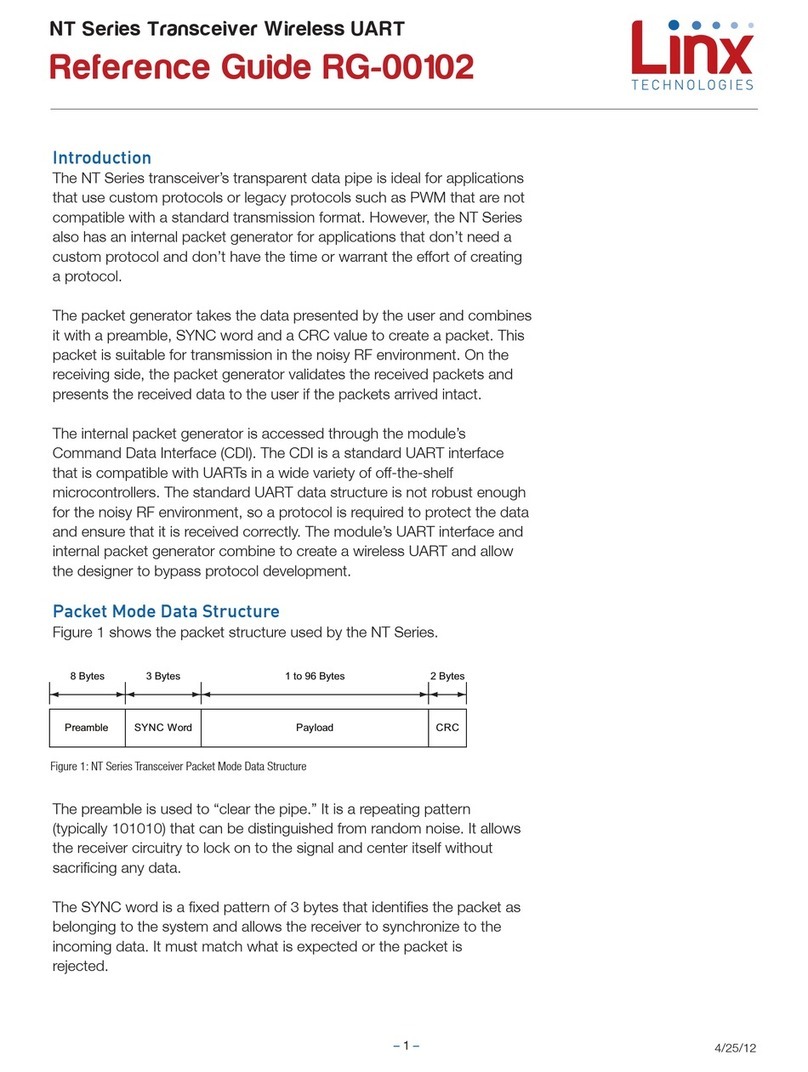
Linx
Linx NT Series User manual
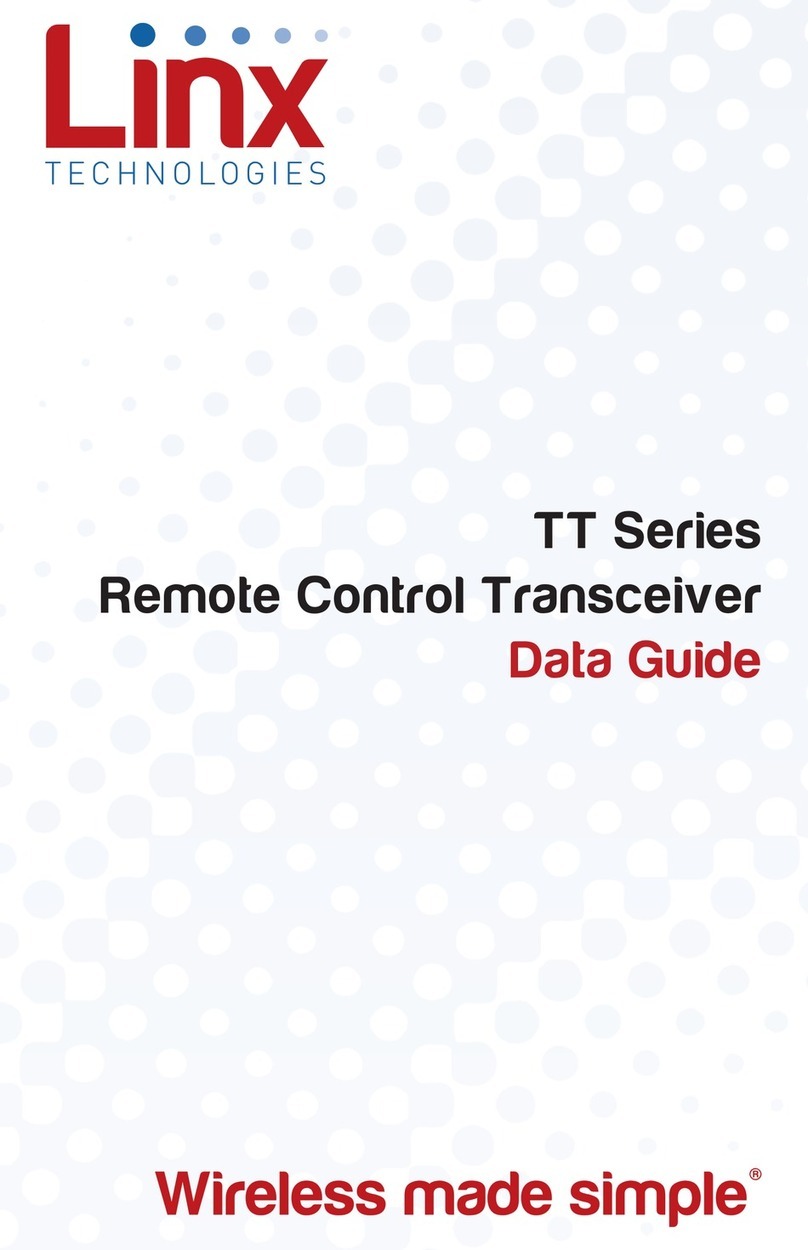
Linx
Linx TRM-900-TT Instruction Manual

Linx
Linx HumRC User manual

Linx
Linx HumPRO Series User manual
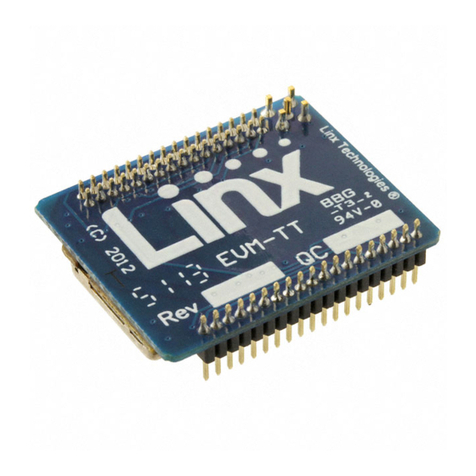
Linx
Linx TT Series Instruction Manual

Linx
Linx HumDT Series User manual
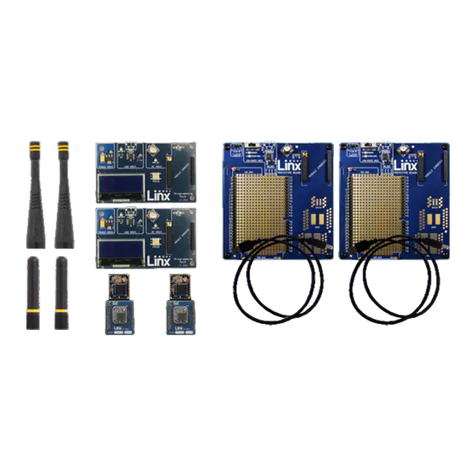
Linx
Linx HumPRO Series Instruction Manual
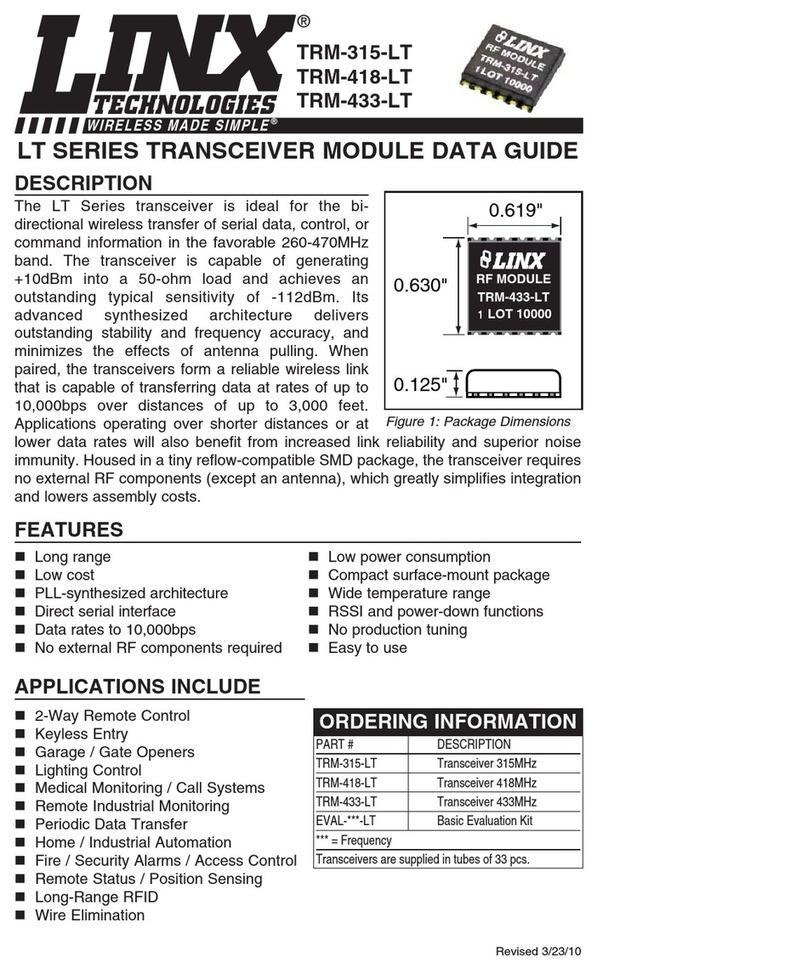
Linx
Linx TRM-315-LT Instruction Manual

Linx
Linx HUM-A-900-PRO-UFL Instruction Manual
